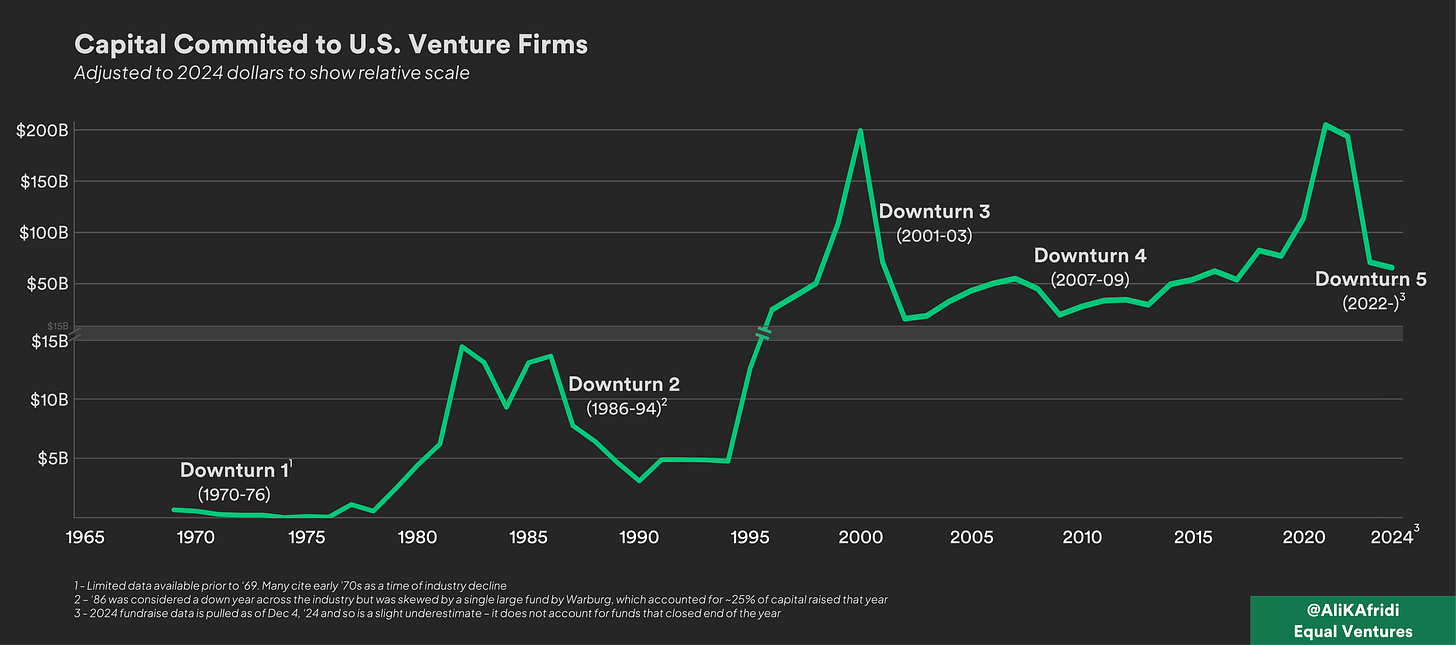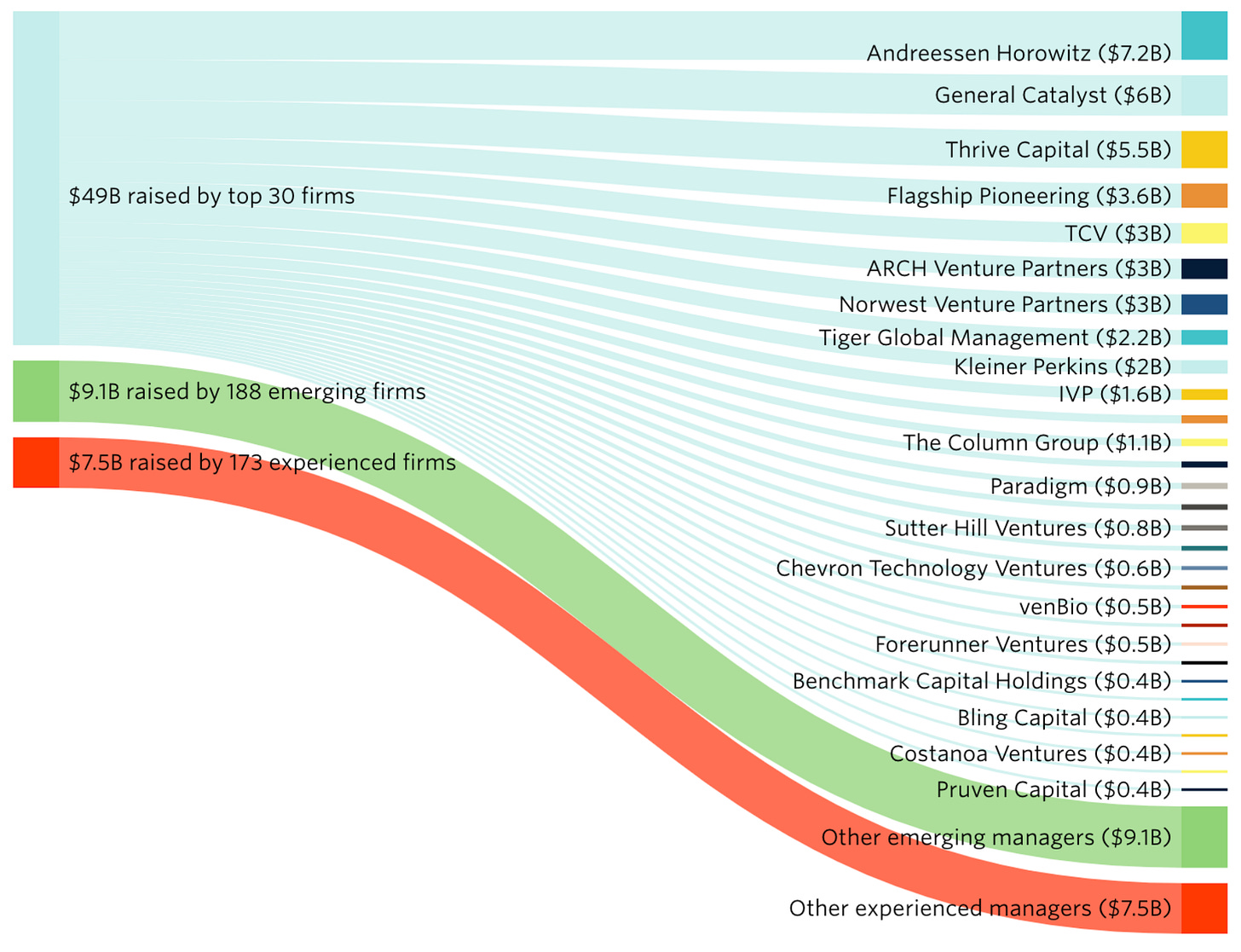#211 VC Math & Top Recent Takes (TRT)
👋 Hi, I’m Doug! Welcome to @TheFundCFO crew! Every Tuesday/[Thursday], we publish VC/CFO insights that matter - highlights from notable VC GPs, LPs, and CFOs/finance pros. Check out our VC Fund Playbooks, Models, Budgets, & Compliance Checklists @ AirstreamAlpha Products!
Need more help? Check out Fund CFO Support provided by the Airstream Alpha Team.
Love what we’re doing? Consider upgrading to paid for deeper dives on Thursdays (most paid subscribers expense these insights!).
Top posts of recent history:
Earlier This Week: PitchBook-NVCA Venture Monitor
Ever quarter, we highly recommend reading the PitchBook-NVCA Venture Monitor. In the report, they provide great market data on what’s going on in VC. Check out our takes here: #210 VC Monitor Report Deep Dive (Q4'24).
VC Math & Top Recent Takes (TRT)
Happy Thursday folks! Today we’re back with some more VC math and hot takes from the week. Below, we share insights on the following posts and more:
What to Expect from VCs if the Downturn Persists (Ali Afridi @ Equal)
Lazard 2024 Secondary Market Report: Secondary Market surges to record $152 Billion Amid Shifting Exit Strategies and Rising Capital Influx
AI-focused startups attracted significant investments, with notable deals such as Meta Platforms’ backing of Databricks in a $10 billion funding round.
Picture of the Day: Snow in Austin, TX (Austin-American Statesman)
Math Behind Venture Capital 15%-20%+ Target Returns
We wrote about this last week (full post linked above) and got a lot of great feedback! How do you do generate >15-20% returns in venture capital? You need a fund model (more below)! Here’s a simple example for the back of the napkin:
$50m fund invests in 25 companies at $2m each (assumes recycling of fees)
Each $2m investment is at a $20m valuation
Own 10% of each company at investment (you own 5% at exit after dilution)
$5 billion of exit outcomes (IPO or sale); your 5% is worth $250m
Returns: MOIC of 5x gross ($250m/$50m), 4.2x net ($210m/$50m)
IRR of 22% gross, 20% net (assumes 8 years to exit)
Key question: do you believe your venture capital fund can generate $5 billion of exit outcomes? Does your fund model support the claim that you can generate the 15-20% net return required by investors?
Top Take: What to Expect from VCs if Downturn Persists
Ali Afridi (@ Equal Ventures) wrote a great post earlier this month on what to expect from venture capital if the downturn persists. Key quotes and highlights:
“Although the venture industry hadn’t seen a downturn in a long time – it is very much in the midst of one following the post-pandemic boom. Firms are shutting down and restructuring, marquee names are returning capital, and the industry is seeing layoffs left, right, and center. Limited Partner (LP) commitments to venture have been down over 60% in 2023 and 2024 compared to the 2 years prior.”
Some of our top highlights of what we may see in the coming years:
Firms shut down and capital consolidates: We’re seeing early signs of this as an initial wave of firms shut down in 2024. Several investors are now predicting the ‘Extinction of Venture Capital’ as we know it5. We’ve also started to see massive capital consolidation – with just 10 firms accounting for over 56% of LP capital raised in 2024.
The downsizing of funds & fees (‘Right-Sizing’): Venture firms tend to balloon in size during the good times. Many raise larger and more frequent funds. This comes crashing down as the tide goes out and LP appetite cools. When this happens, many firms choose (or are forced) to raise smaller funds deemed to be more reasonable to invest in just the highest quality opportunities67. In parallel, many firms that have been able to get away with premium fees are forced to revert to industry standards if they haven’t demonstrated excess returns.
Firms shift to other asset classes: Over the past 15 years, we’ve seen many firms choose to raise ever larger funds and in parallel build out large platform teams of ex-operators to support portfolio companies. If the pattern continues, we may see many of these firms look to expand into other assets, bringing a new definition to crossover funds15.
Venture Capital Unbundled
Kyle Harrison shared an insightful post this month diving into the “unbundling” of traditional venture capital. Here’s some key quotes:
“Venture capital has started to revolve around the concept of "2% of the biggest number." Bigger funds, bigger teams, bigger portfolios, bigger checks, higher deployment velocity.”
“But the reality is that venture capital has always been a game of power laws (as well as a magnet for hucksters and charlatans). So once you (1) wash out the wanna-bes, and (2) fixate the aperture on the power law of investors, you see a different trend.”
“Amongst names that matter, the trend is not retreat or death. It is unbundling.”
In 2024, 75% of all venture dollars was raised by just 30 firms.
The size and scale of these pools of capital is a fundamentally different thing. It requires different attitudes and approaches. It requires different portfolio construction and risk tolerance. It also provides a fundamentally different economic product.
How Does This Deal RTF? Breaking Down Investing Math
Every venture fund manager aims to deliver exceptional performance. Before committing to any deal, a VC fund investor should ask: “How does this deal RTF? Can it 2x or 3x RTF? What assumptions about the future must hold true for this to happen?”
Keep reading with a 7-day free trial
Subscribe to @TheFundCFO Newsletter to keep reading this post and get 7 days of free access to the full post archives.





